Your Call?
Which two images of today’s six featured images do you like best? Why?
In a Previous Blog Post
Thanks to the many who left comments at The Sony 400mm f/2.8 GM Lens & DeSoto’s North Beach blog post here. Several folks liked the scratching GBH best, but the practically monotoned Snowy Plover image, #1, was the clear favorite. It is strange how such a simple image with worm hill curves and light tans, grays, and beiges can be so successful.
What’s Up?
With an unexpected inch of fresh snow, the first Homer group has been 100% blessed. The light reflects off the snow and illuminates the undersides of the eagle’s wings perfectly. In addition we’ve had clouds and relatively warm temperates with little wind. In short, pretty close to perfect. And we’ve ended each sailing with a harbor session photographing Harbor Seal (of course), Sea Otter, Common Goldeneye, Common Loon, Short-billed Gull
Today is Sunday 16 February. We are meeting the captain at 9:30am. Whatever you do, I hope that you have as much fun as we do.
If an item — a Delkin flash card, or a tripod head — for example, that is available from B&H and/or Bedfords, is also available in the BAA Online Store, it would be great, and greatly appreciated, if you would opt to purchase from us. We will match any price. Please remember also to use my B&H affiliate links or to earn 3% cash back at Bedfords by using the BIRDSASART discount code at checkout for your major gear purchases. Doing either often earns you free guides and/or discounts. And always earns my great appreciation.
Supporting My Efforts Here
If you enjoy and learn from the blog, are all set for gear, or live overseas, consider leaving a BAA Blog Thank You Gift here.
If you enjoy and learn from the blog, please consider using one of my affiliate links when purchasing new gear. It will never cost you a single penny. To support my effort here, please order from B&H by beginning your search here. Or, click here, to order from Bedfords and enter the discount code BIRDSASART at checkout to receive 3% cash back to your credit card and enjoy free Second-Day Air Fed-Ex shipping. It is always best to write for advice via e-mail.
In many cases, I can help you save some serious dollars. And/or prevent you from purchasing the wrong gear from the wrong shop.
|
|
|
This image was created on 13 February 2025 at Anchor Point, AK. Standing at full height, I used the Robus RC-5570 Vantage Series 3 Carbon Fiber Tripod/Levered-Clamp FlexShooter Pro-mounted Sony FE 600mm f/4 GM OSS lens with the Latest Greatest Sony Flagship Body, the a-1 ii Mirrorless Camera. The exposure was determined via Zebras with ISO on the thumb dial. ISO 3200: 1/500sec. at f/4 (wide open) in Manual mode. AWB at 9:28:42am on a cloudy morning. Tracking: Zone/AF-C with Bird-Eye/Face Detection performed perfectly. Click on the image to enjoy the high-res version. Image #1: Pine Grosbeak, bright male on Mountain Ash berry cluster |
The Pine Grosbeaks
The Pine Grosbeaks were not as plentiful at the Anchor Point feeders as they had been in previous years; and the males were scarce. We learned on our first morning that they came in quite early so on Day 2 we arrived 30 minutes earlier than we had on Thursday and were blessed early on by the presence of this handsome male and several females — one below.
|
|
|
This image was also created on 13 February 2025 at Anchor Point, AK. Again, standing at full height, I used the Robus RC-5570 Vantage Series 3 Carbon Fiber Tripod/Levered-Clamp FlexShooter Pro-mounted Sony FE 600mm f/4 GM OSS lens with the Latest Greatest Sony Flagship Body, the a-1 ii Mirrorless Camera. The exposure was determined via Zebras with ISO on the thumb dial. ISO 5000: 1/800sec. at f/4 (wide open) in Manual mode. AWB at 9:30:27am on a cloudy morning. Tracking: Zone/AF-C with Bird-Eye/Face Detection performed perfectly. Click on the image to enjoy the high-res version. Image #2: Pine Grosbeak, female on Mountain Ash berry cluster |
Shutter Speeds
Those who viewed the epic and comprehensive Shutter Speeds for Bird Photography YouTube video (5,600+ views) here, know that when mild action might be expected, you are a lot better off at 1/800 or 1/1000 second than you are at 1/500. On day one, I lost some nice images at 1/400 and 1/500 sec. to motion blur. Those latter shutter speeds (and even slower ones down to /60 sec.) are perfectly fine if the birds are perfectly still (as with Image #1, above).
So, on Day 2, I promised myself to work just a bit faster. 1/800 sec was just fast enough to yield a sharp face and eye when the lady grosbeak violently ripped a berry from the cluster and sent the frost flying.
Shutter Speeds for Bird Photography
Learn about choosing a suitable shutter speed for all types of bird photography — for static subjects, for flight, and for various types of action. Not to mention for creating the pleasingly blurred images that I love. There is so much info in this 46 minutes video that serious bird photographers will wish to bookmark it for study.
Learn more and see my expanded summary in the blog post here.
|
|
|
This image was also created on 13 February 2025 at Anchor Point, AK. Again, standing at full height, I used the Robus RC-5570 Vantage Series 3 Carbon Fiber Tripod/Levered-Clamp FlexShooter Pro-mounted Sony FE 600mm f/4 GM OSS lens with the Latest Greatest Sony Flagship Body, the a-1 ii Mirrorless Camera. The exposure was determined via Zebras with ISO on the thumb dial. ISO 2000: 1/5000sec. at f/4 (wide open) in Manual mode. AWB at 10:48:52am on a cloudy morning. Tracking: Zone/AF-C with Bird-Eye/Face Detection performed perfectly. Click on the image to enjoy the high-res version. Image #3: Gray Jay taking flight |
Learning More About Making Pre-Capture Miracles
I made some progress on Day 1, but on Day 2 things really jelled. Understanding that at age 78, with my reflexes and reaction time totally shot, that with Pre-Capture set to one second with the a-1 ii I could press the shutter button after the bird took flight and still create some very special images. That of course, provided that you had the shutter button half-pressed (as discussed here recently).
To reiterate, while I strive to press the shutter button just as the bird leaves the perch, doing so is not 100% necessary. As above, you can press the shutter button after the bird leaves the perch and still come up smelling like roses.
Should You Upgrade to or Purchase a Sony a-1 ii?
I ordered my second a-1 ii two days ago. Every day that I use mine, the more I am amazed by speed and accuracy of the Bird Face-Eye tracking in AF-C and the overall performance of the camera.
Aside from the improved ergonomics as compared to the a-1, other nice features include the fact that the rear screen tilts both ways. Pre-capture will surely prove to be a plus while in my option, the Speed Boost feature is a total waste for bird photography. In addition, the resolution on the rear monitor has been improved dramatically. Not to mention at Bird Face-Eye tracking on the a-1 ii is vastly improved as compared to both the a-1 and the a9 iii and that the 51MP files are to die for. And don’t forget the Pre-Capture feature!
So, the big question is, is the a-1 ii “worth” a gear upgrade. Remembering that I can never know whether or not something is worth it to you, I can say that I was not floored when using my a-1 ii. The differences between the a-1 ii and the original a-1, are neither huge nor eye-opening. The huge difference between the new camera body and the a9 iii is, of course, the 51MP a-1 raw files (as compared to the 24MP files rendered by the a9 iii).
With the price of a new a-1 having recently dropped $1500.00 to $4,998.00, the decision for new Sony buyers is a very tough one. The a-1 ii sells new for $6,498.00. And the price of used a-1 bodies will continue to drop (but surely not as much as I had thought before using the a-1 ii).
If you do purchase an a-1 ii, be sure to use one of my two affiliate links so that you will receive my a-1 ii settings (in the form of a CAMSEa1ii.DAT file), the Buttons and Dials Guide, and an Info Sheet. Folks who do not purchase their new a-i using my B&H link or from Bedfords here and entering the BIRDSASART discount code at checkout will be able to purchase the a-1 ii guide for $227.43. If you are at all confused and do not want to screw up your order, please get in touch via e-mail.
|
|
|
This image was also created on 13 February 2025 at Anchor Point, AK. Again, standing at full height, I used the Robus RC-5570 Vantage Series 3 Carbon Fiber Tripod/Levered-Clamp FlexShooter Pro-mounted Sony FE 600mm f/4 GM OSS lens with the Latest Greatest Sony Flagship Body, the a-1 ii Mirrorless Camera. The exposure was determined via Zebras with ISO on the thumb dial. ISO 4000: 1/5000sec. at f/4 (wide open) in Manual mode. AWB at 1:22:03pm on a very cloudy afternoon. Tracking: Zone/AF-C with Bird-Eye/Face Detection performed perfectly. Click on the image to enjoy the high-res version. Image #4: Boreal Chickadee taking flight |
Using Crazy High ISOs
To utilize super fast shutter speeds like 1/4000, 1/5000, and even higher when attempting to photograph songbirds in flight in low light, the use of very high ISOs is mandatory. That said, most of today’s flight and action shots were somewhat under-exposed. My double noise reduction techniques detailed in Digital Basics II and the Digital Basics III Video Series yielded clean smooth noise-free backgrounds with today’s images.
Note: here again, the shutter button was not fully depressed until after the bird took flight. This image was 100% possible for me only because of Pre-Capture.
|
|
The BIRDS AS ART Current Workflow e-Guide (Digital Basics II).You can order your copy from the BAA Online Store here, by sending a PayPal for $40 here, or by calling Jim or Jennifer weekdays at 863-692-0906 with your credit card in hand. Be sure to specify Digital Basics II. |
The BIRDS AS ART Current Workflow e-Guide (Digital Basics II)
The techniques mentioned above and tons more great Photoshop tips and techniques — along with my complete digital workflow, Digital Eye Doctor Techniques, and all my personalized Keyboard Shortcuts — are covered in detail in the BIRDS AS ART Current Workflow e-Guide (Digital Basics II), an instructional PDF that is sent via e-mail. Note: folks working on a PC and/or those who do not want to miss anything Photoshop may wish to purchase the original Digital Basics along with DB II while saving $15 by clicking here to buy the DB Bundle.
Please note: the Divide and Conquer technique was inadvertently omitted from DB II. It is detailed in a free excerpt in the blog post here.
Folks who learn well by following along rather than by reading can check out the complete collection of MP 4 Photoshop Tutorial Videos by clicking here. Note: most of the videos are now priced at an amazingly low $5.00 each.
You can learn how and why I converted all of my Canon digital RAW files in DPP 4 in the DPP 4 RAW Conversion Guide here. More recently, I became proficient at converting my Nikon RAW (NEF) files in Adobe Camera Raw. About three years ago I began converting my Nikon and Sony RAW files in Capture One and did that for two years. You can learn more about Capture One in the Capture One Pro 12 Simplified MP4 Video here. The next step would be to get a copy of Arash Hazeghi’s “The Nikon Photographers’ Guide to Phase One Capture One Pro e-Guide” in the blog post here. Today, I convert my Sony raw files in Photoshop with Adobe Camera Raw.
You can learn advanced Quick Masking and advanced Layer Masking techniques in APTATS I & II. You can save $15 by purchasing the pair.
|
|
The Digital Basics III Video Series |
The Digital Basics III Video Series
I realized more than a year ago that my digital workflow had changed significantly and was toying with the idea of writing a Digital Basics III. More recently, I learned and began working with two great new Photoshop Tools, the Remove Tool and the Luminance Targeted Adjustment Tool. The former is like a smarter Spot Healing Brush Tool on steroids and the latter is a step up from the fabulous Color Mixer Tool. During that same time frame, I came up with a new and improved 2-step noise reduction technique. I still use Divide and Conquer, Quick Masks, Layer Masks, an expanded array of personalized keyboard shortcuts, and tons of other stuff from both versions of Digital Basics.
As soon as I realized that I did not want to take on another large writing project, I realized that by creating a series of videos I could much more easily share all the details of my current digital workflow and much more easily incorporate additional new tips, techniques, and tools as I went. And so, The Digital Basics III Video Series was born.
You can order the first five videos in Volume I — 15 detailed image optimizations that cover a wide variety of challenges, by clicking here. The videos will be most valuable for folks using the latest version of Photoshop (2024) or Lightroom along with Topaz DeNoise AI and Topaz Sharpen AI.
|
|
|
This image was also created on 13 February 2025 at Anchor Point, AK. Again, standing at full height, I used the Robus RC-5570 Vantage Series 3 Carbon Fiber Tripod/Levered-Clamp FlexShooter Pro-mounted Sony FE 600mm f/4 GM OSS lens with the Latest Greatest Sony Flagship Body, the a-1 ii Mirrorless Camera. The exposure was determined via Zebras with ISO on the thumb dial. ISO 4000: 1/4000sec. at f/4 (wide open) in Manual mode. AWB at 1:48:29pm on a very cloudy afternoon. Tracking: Zone/AF-C with Bird-Eye/Face Detection performed perfectly. Click on the image to enjoy the high-res version. Image #5: Pine Siskin, bright male on Mountain Ash berry cluster |
Square Crops
As with Image #1, above, and as seen here often recently, square crops often work exceedingly well. While I am not a fan of the horizontal gray area in the background in front of the bird’s feet, the square crop reduced its impact on the image as compared to the original 3X2 capture.
|
|
|
This image was also created on 13 February 2025 at Anchor Point, AK. Still standing at full height, I used the Robus RC-5570 Vantage Series 3 Carbon Fiber Tripod/Levered-Clamp FlexShooter Pro-mounted Sony FE 600mm f/4 GM OSS lens with the Latest Greatest Sony Flagship Body, the a-1 ii Mirrorless Camera. The exposure was determined via Zebras with ISO on the thumb dial. ISO 4000: 1/5000sec. at f/4 (wide open) in Manual mode. AWB at 1:49:27pm on a very cloudy afternoon. Tracking: Zone/AF-C with Bird-Eye/Face Detection performed perfectly. Click on the image to enjoy the high-res version. Image #6: Black-capped Chickadee taking flight |
Faster and Whiter!
The Black-capped Chickadees are absolute speedsters as compared to the Boreals. And the brighter white feathers require 1/3 stop less light than the other species. I accomplished that by raising the shutter speed click. The key to getting an action shot of a black-capped is to get on them quickly and acquire focus ASAP. You usually do not have to wait long for this jittery species to take flight.
Note: this is another Pre-Capture miracle; I did not press the shutter button until after the bird took flight.
Typos
With all blog posts, feel free to e-mail or to leave a comment regarding any typos or errors.

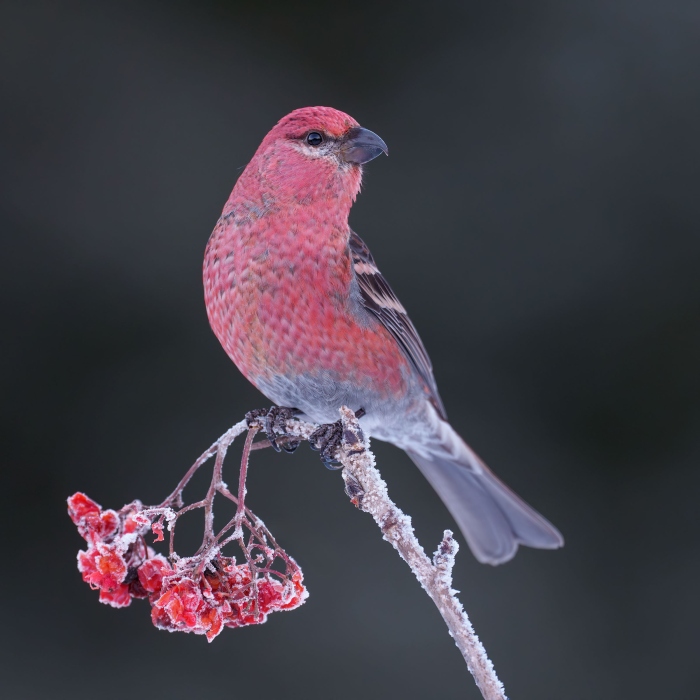
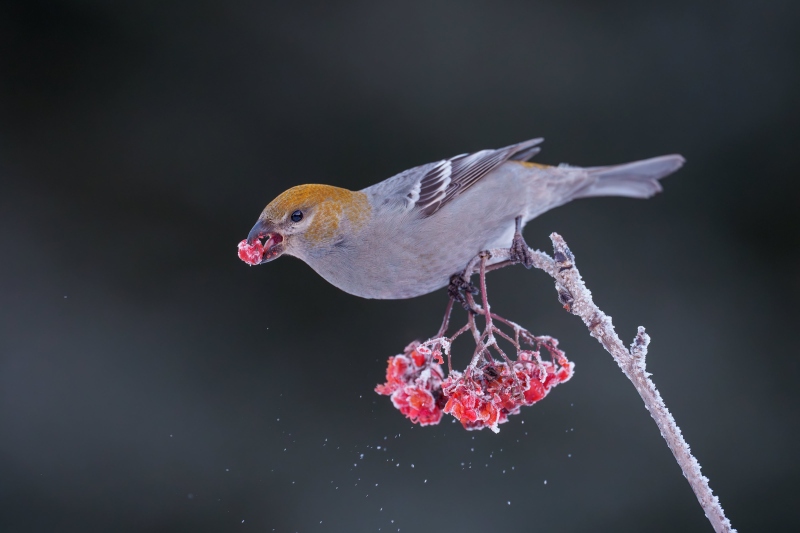
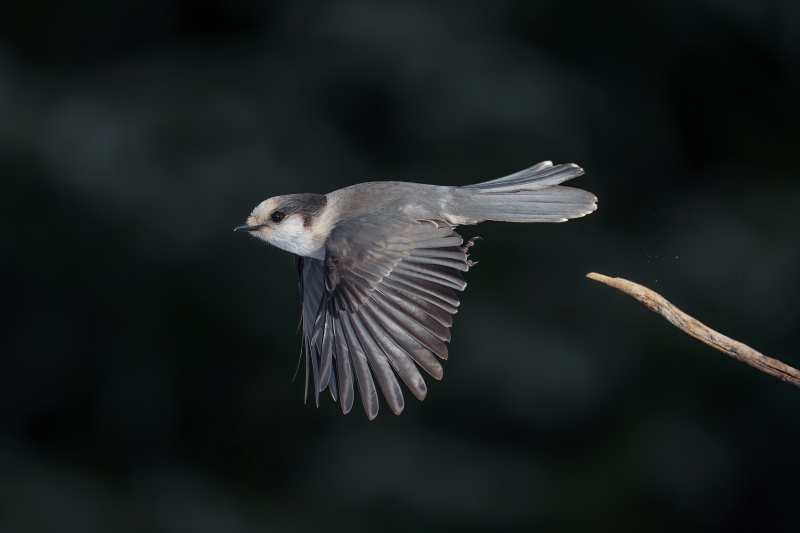
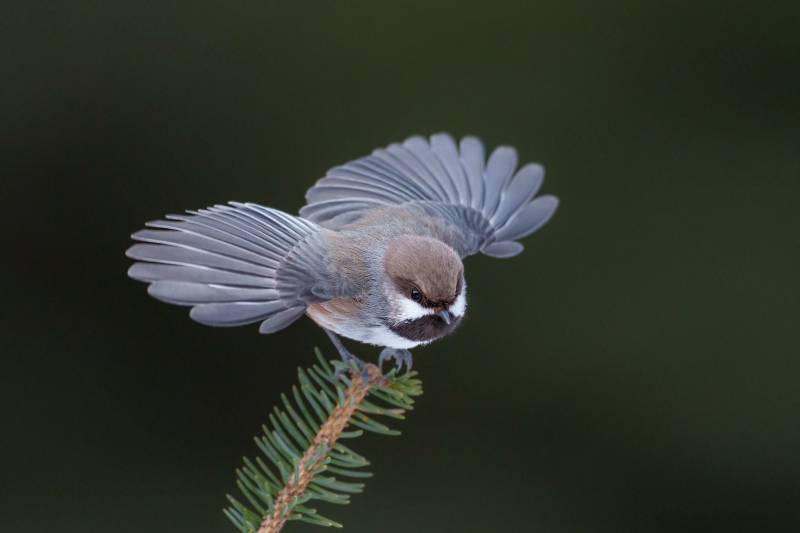
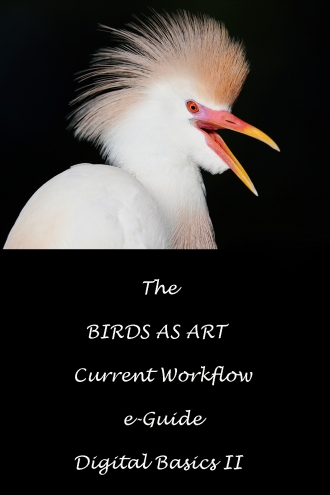
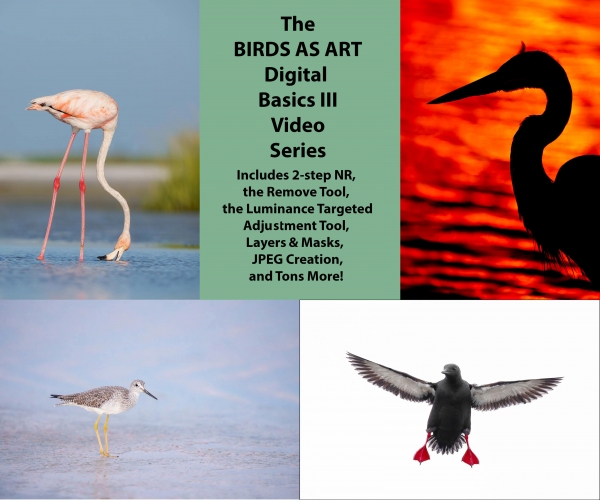
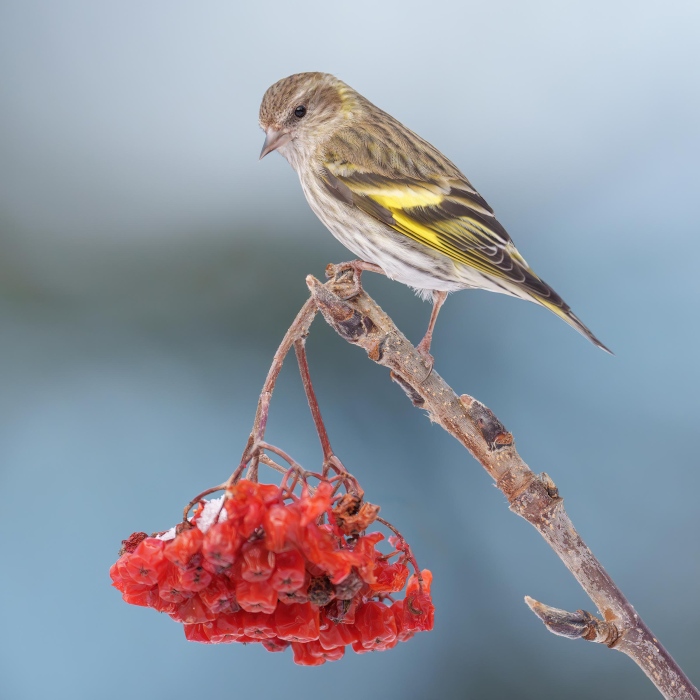
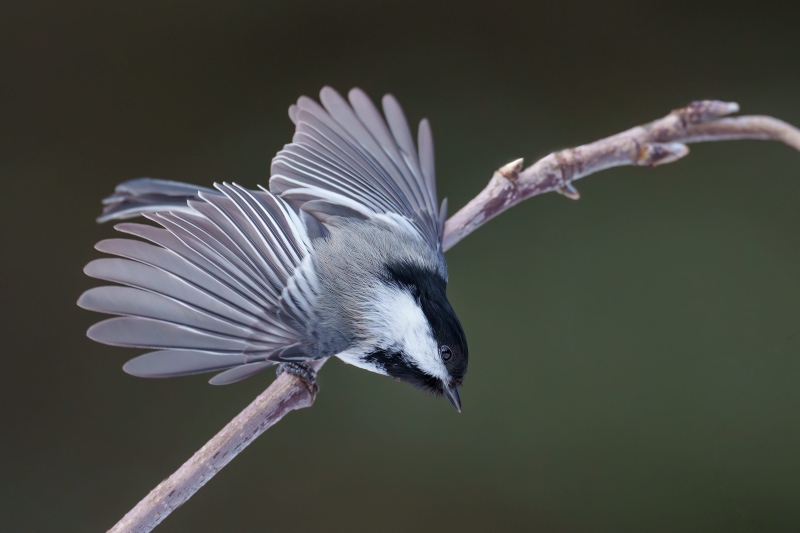






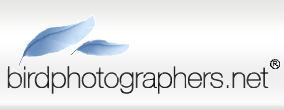


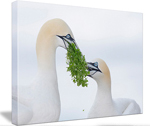



1,2,5 then all the rest. #1 could go on your wall of best.
Love the Boreal Chickadee with the Black Capped a close second . The Boreal is stunning with the dark background and the start of flight . Did you use pre-capture on these images ?
Hi Bill,
Perhaps you read an early version of the blog. Almost immediately, I added this to the boreal text:
Note: here again, the shutter button was not fully depressed until after the bird took flight. This image was 100% possible for me only because of Pre-Capture.
And this below the black-capped:
Note: this is another Pre-Capture miracle; I did not press the shutter button until after the bird took flight.
My reaction times were so delayed, that I increased the Pre-Capture time to a full one second.
with love, artie
#1 Composition and the Colours. #6 – Beautiful wing pattern.
My two favorites: #4 Boreal chickadee (you can see the momentum as that little guy takes flight against the dark background, which makes the bird “pop”) and #3 Gray Jay (I like the fact that you included the stick the bird took flight from and the dark background).
Thanks Pat!
much love, artie
I like #1 and #2 best, but I’d like to mention that I like ALL of the images better than the usual shots of water birds.
Bummer for you. I love the beach.
a
A minor point: Gray Jay is now officially known as Canada Jay (don’t tell the occupants of the
White House). I prefer the old nickname “Whiskey Jack!”
Thanks, Blair. Good to see that you are still kicking. Me too. How are the dragonflies doing?
As far as the names of bird, I am old school and prefer to stick with the “old” (politically incorrect) names. What did MacGillivray ever do wrong?
with love, a